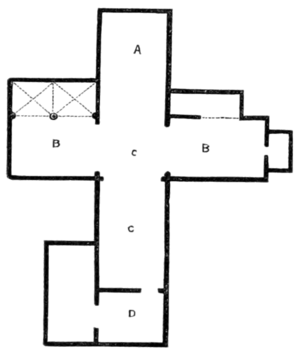to erect several altars in each transept. In this case sometimes two or more small apses were added side by side, as in the eastern transepts at Canterbury; but it seems to have been more common in this case to add what architecturally forms an eastern aisle to the transept, even when there is no western one, as at Peterborough. The bays of these aisles formed chapels, usually screened off from one another, and each contained an altar. This strikes me as an arrangement decidedly inferior to that of the attached apses; the latter proclaim their purpose within and without, while an aisle in no way puts itself forward as a receptacle for altars; indeed we rather expect to find it forming a continuous passage. Numerous examples of this arrangement occur in large churches; I prefer quoting a Sussex example on a very small scale, dating within the period of Transitional Norman.
This is at Sompting, a church famous for its Saxon tower, but hardly less worthy of attention on other grounds. The north transept has an eastern aisle of two bays, divided by a pillar, and vaulted; each undoubtedly contained an altar. The transepts at Broadwater, in the same county, had also each of them three chapels attached in a similar manner to the east, which are now unfortunately destroyed. At Sompting, and I imagine at Broadwater, this eastern addition was architecturally a regular aisle in the strictest sense, marked as such in the continuous roofing without, and the

